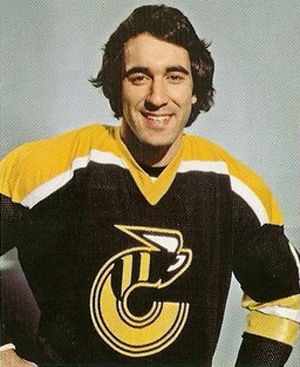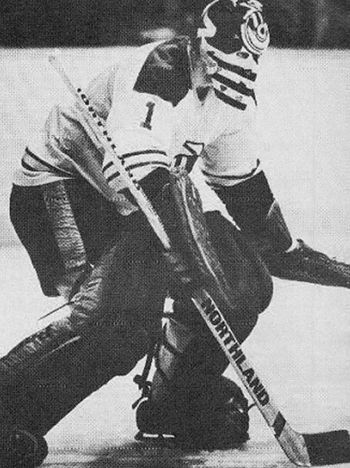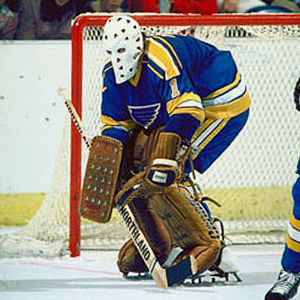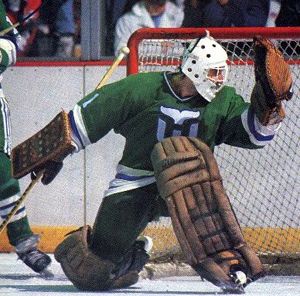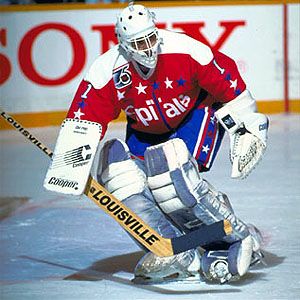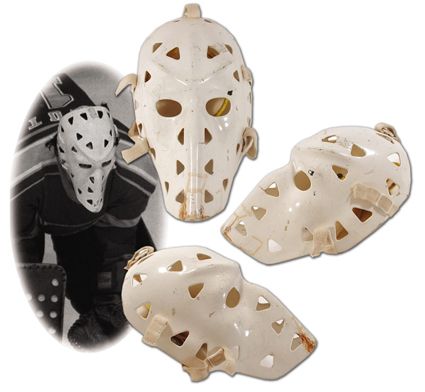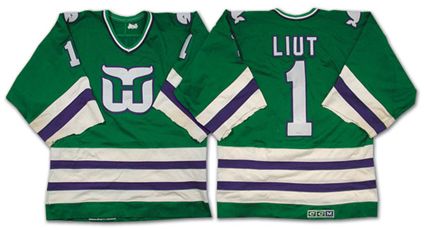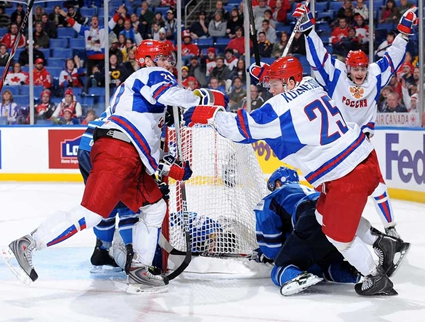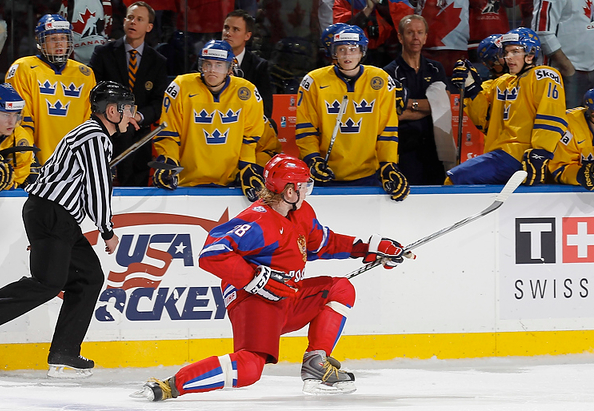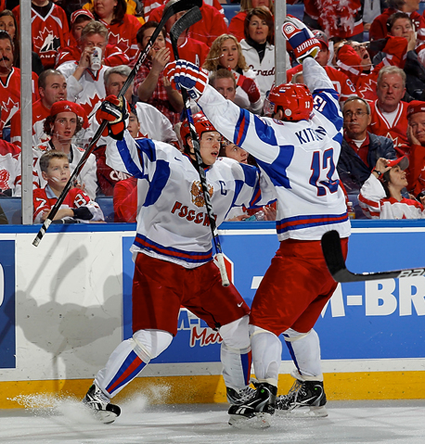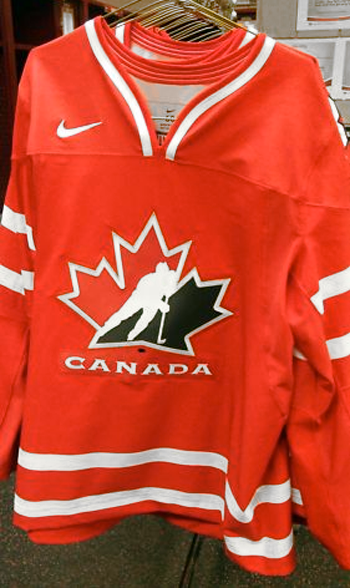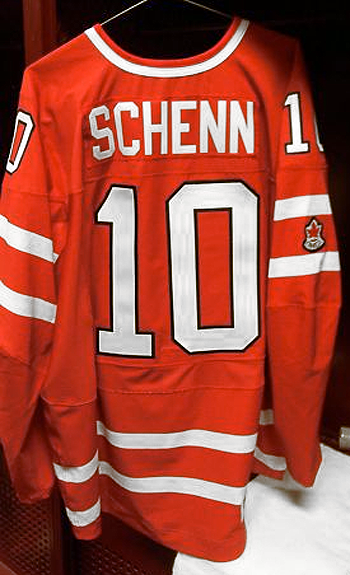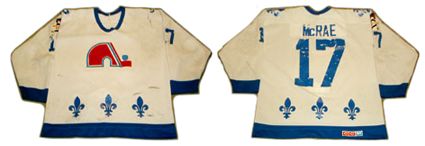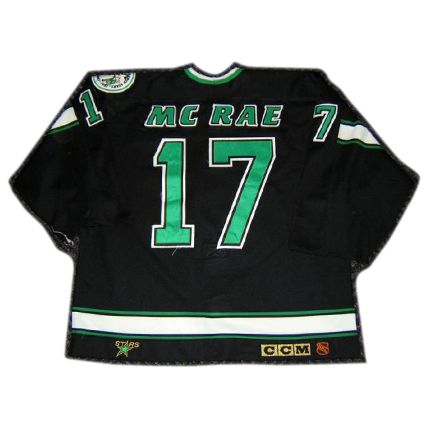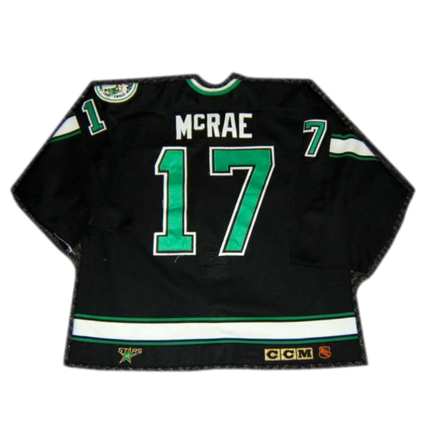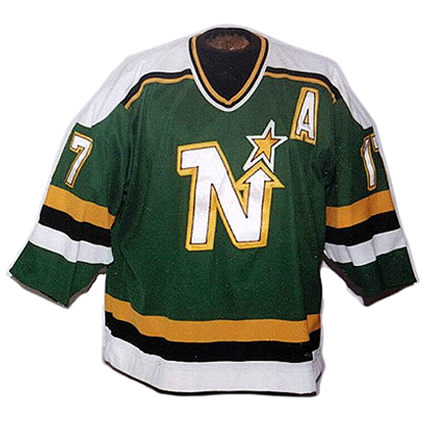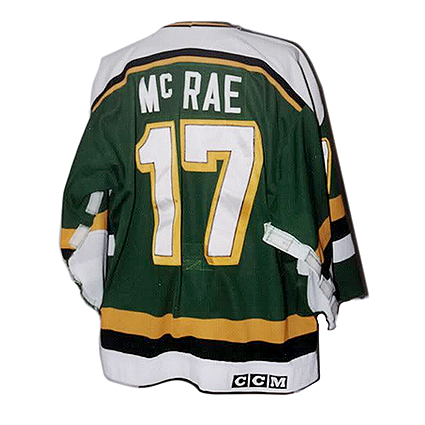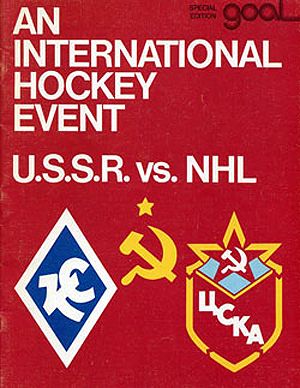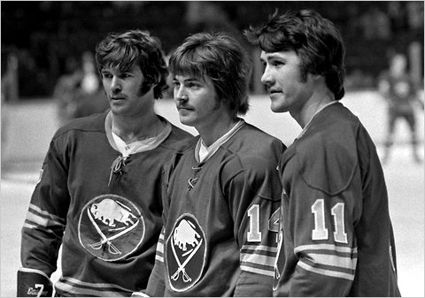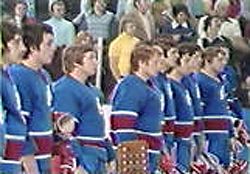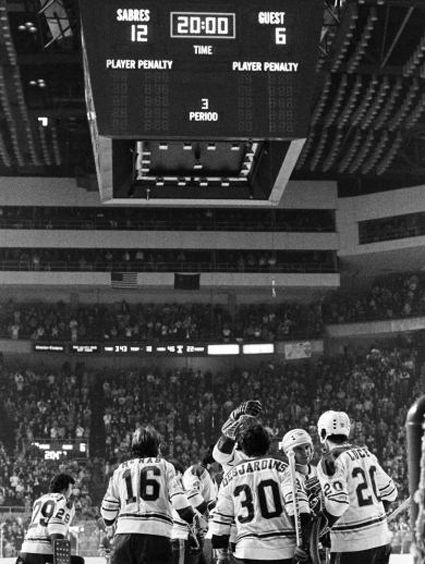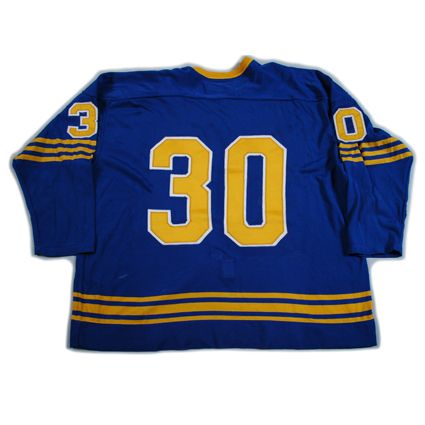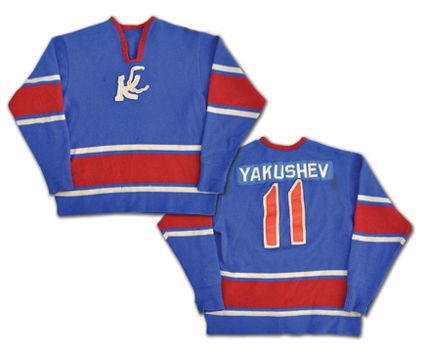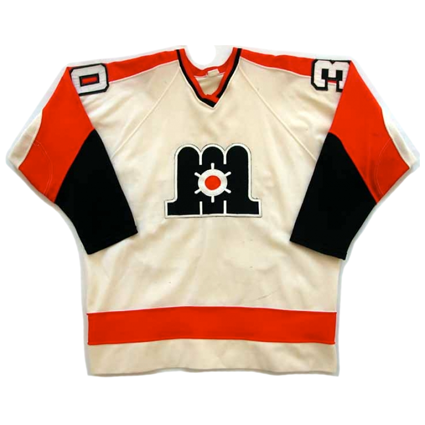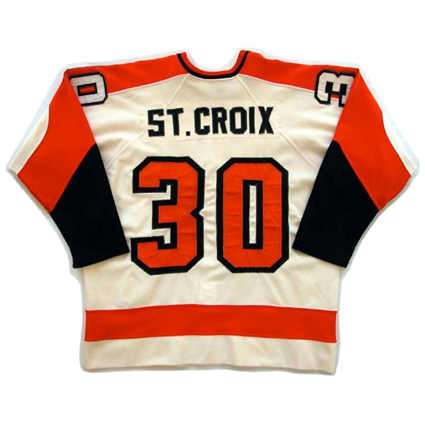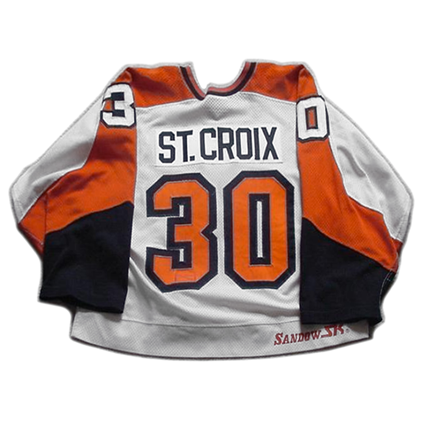Friday, January 7, 2011
1984-85 Hartford Whalers Mike Liut Jersey
While attending Bowling Green University from 1973-74 to 1976-77, goaltender Mike Liut was named to the CCHA First All-Star Team twice and named the CCHA Player of the Year in 1977. Also while at Bowling Green, Liut was drafted by the St. Louis Blues in the 1976 NHL Amateur Draft.
Liut chose instead of join the Cincinnati Stingers of the rival World Hockey Association for the 1977-78 season and played in 27 games as a backup.
For 1978-79 he took over as the number one goalie for the Stingers and won 23 games in 54 appearances in what was the last season of the WHA.
His rights were reclaimed by the Blues as part of the provisions of the merger between the NHL and WHA and Liut was immediately installed as the Blues starter, a position he held down for the next five seasons. He introduced himself to the NHL with 32 wins in his first season to lead the league and 33 wins the next, which led to a runner-up finish in the Hart Trophy voting for league MVP. He was however, awarded the 1981 Lester Pearson Award for league MVP as voted by the players. He also appeared in the 1981 NHL All-Star Game where he was named the game's MVP.
On the heels of his outstanding regular season, Liut was named the starting goaltender for Team Canada for the 1981 Canada Cup, where he led Canada to the finals with a 4-1-1 record in six games.
For the next three seasons with the Blues Liut played strongly and averaged 25 wins per season. He was on his way to a repeat of those numbers when he was traded to the Hartford Whalers midway through the 1984-85 season.
As the Whalers lead goaltender Liut continued his solid play, leading the league in shutouts with four in 1986-87, no mean feat during the high scoring 1980's. In his first season with the Whalers, Liut recorded 27 wins and then topped 30 for the third time in his career with 31, followed by 25 more in 1987-88.
In the 1989-90 season Liut led the league with the lowest goals against average of 2.53 despite a late season trade to the Washington Capitals. For the final two seasons of Liut's career he shared time with incumbent Don Beaupre before being forced to retire due to back problems.
Throughout his career he became recognized for both his #1 sweater he wore during his entire career, as well as his distinctive snow white mask, which remained unadorned throughout his NHL career despite his flashy mask worn while in the WHA.
Liut finished his career with 294 wins and 25 shutouts in 14 NHL seasons in addition to the 31 wins and 4 shutouts he recorded in the WHA.
Today's featured jersey is a 1984-85 Hartford Whalers Mike Liut jersey. This would be the only season Liut would wear this specific style of jersey, as the next season Pucky the Whale would disappear for good from the shoulders of the jerseys and the green stripe at the bottom of the jersey would also vanish, making the bottom of the sweaters white from then on.
Today's video selection is a run down of the 1988-89 Hartford Whalers and their many pornstaches.
Here is video of Liut in a game against the Philadelphia Flyers. Note the "birdcage" helmet he's wearing rather than his trademark mask, as well as the short-lived Blues jerseys with the team name on the front, worn only for three seasons starting with 1984-85, the year Liut was traded to Hartford.
Labels:
Hartford Whalers,
Liut Mike
Thursday, January 6, 2011
2010-11 Team Canada Brayden Schenn Jersey
The Kardiac Kids (Сердечная детей) from Russia pulled off the third and most spectacular comeback of the 2011 World Junior Championship last night. Not only was it their most spectacular comeback of this year's tournament, but it was also the greatest comeback in a gold medal final in the history of the World Juniors.
Russia opened their tournament looking outgunned as they hung with Canada through two periods before Canada pulled away convincingly with three goals in the third period to win 6-3. Things did not get any easier for Russia when they gave up two first period goals to Sweden and had no answer for the Swedish defense, which held them scoreless to win 2-0, leaving Russia halfway through their Group B schedule tied with Norway at exactly zero points.
Fortunately for Russia, out manned Norway was next on their schedule and an 8-2 win was an opportunity to get some much needed points in the standings and regain some needed confidence. With Sweden and Canada stealing the headlines with their matchup for the bye that came with winning Group B, Russia faced off against the Czech Republic to determine who would advance to the playoff round and an all-important chance to wipe their slate clean.
Russia took care of business for the second game in a row, building an 8-2 lead after two periods to escape the Preliminary Round and head into a quarterfinal matchup with the second place team in Group A, Finland.
Although Russia scored first half way through the first period, Finland equalized in the first period, added a second in the second and built their lead to 3-1 with a goal 2:24 into the third. When the Finns took their third penalty of the period with five and a half minutes remaining, Russia got the opportunity they needed. Or at least the opportunity Yevgeni Kuznetsov needed.
The Washington Capitals draft pick simply took the game into his own hands and crammed in a shot that appeared to be under the Finnish goaltender Joni Ortio. A minute later Kuznetsov skated into the Finnish zone and through the defense to put a solid shot on goal, which Ortio could not corral and Maxim Kitsyn converted the rebound into a tie score, which would last through the end of regulation.
Kuznetsov celebrates Russia's comeback against Finland
After trading chances, Kuznetsov received the puck from Kitsyn along the boards, cut toward the middle of the ice and fired a laser past a screening defenseman and over Ortio's shoulder to pull one out of the fire for Russia and advance them a quarterfinal rematch against Group B winner Sweden.
Russia scored the first two goals, but found themselves in peril when Sweden came back to tie the game 1:20 into the third period and scored with 3:19 remaining in the third period to put themselves in position to advance to the gold medal game. The Russians were not done, however, as Sergei Kalinin rammed in a loose puck with a dramatic diving stab with 1:27 remaining to keep the Russians alive and send the game into overtime.
The overtime settled nothing despite Sweden outshooting Russia 5-1 and the contest moved to a shootout. Denis Golubev scored on Russia's second shot and Dimitri Shikin made all three saves Russia needed to win the shootout and advance to the finals to meet Canada, who overpowered the United States 4-1.
Golubev celebrates his shootout goal
Canada, backed by a thousands and thousands of red-clad Canadian fans from just over the border from Buffalo, opened the scoring at 4:50 with a power play goal and extended their lead at the end of the first period when Carter Ashton scored with just 13.5 seconds remaining.
Canada again had their way in the second period, holding Russia off the board and also adding to their lead when Brayden Schenn hammered a one-timer past a helpless Shikin at 6:27 to tie the Canadian record for most points in a World Junior tournament with 18 from 8 goals and 10 assists. It was to be his last point of the tournament.
And Canada's.
Shikin was pulled in favor of Igor Bobkov, who's only prior action was letting in 6 goals to Canada in their opening game of the tournament. At this point Canada had outscored Russia 6-0 over the last three periods of play against each other heading into the third period, which had all the feeling of a victory lap for Canada on their way to the gold medal.
Russia broke the shutout at 2:33 on a goal by Artemi Panarin on a wrist shot over Canadian goaltender Mark Visentin's glove to make it 3-1, but no cause for alarm. The Canadian fans sat up straight however when Russia caught everyone off guard when Kitsyn squeezed a shot through Visentin's pads to make a game of it for the first time all night.
In a development worthy of a Hollywood movie, Russian captain Vladimir Tarasenko, who had left the game in the second period after taking a hard blow from a Canadian player's shin while he was prone on the ice, took a great pass from Kuznetsov to tie the game at 7:29, their third goal in less than 5 minutes, and fully energize the Russian squad.
Tarasenko gets up off the mat to take part in the shocking Russian comeback
The tables were fully turned when the Russians refused to let the Canadians repeatedly clear the zone and Tarasenko worked a perfect give-and-go with Panarin, who buried the puck deep into the back of the net for the first Russian lead with 4:16 to play.
Nikita Dvurechenski put the game out of reach when he easily scored the fifth even strength goal of the period for Russia when he easily won a race to a loose puck in the Canadian zone and put it between Visentin's legs at 18:44 to begin the Russian celebration and leave the Canadian faithful in stunned silence.
Panarin finished with two goals and Kuznetsov had three assists in the third period turnaround to lead the Russians to a shocking gold medal, completing their third consecutive come from behind victory and become the first team to win the World Juniors after losing their first two games.
2011 World Junior gold medal champions Russia
Today's featured jersey is a 2010-11 Team Canada Brayden Schenn jersey. Schenn led all tournament scorers with 8 goals, 10 assists and 18 points and was named to the tournament All-Star Team, was named the Best Forward of the tournament and the tournament's Most Valuable Player. Despite all the personal awards he gathered, he came away without the one he really wanted, the gold medal.
Schenn's jersey worn in Canada's game on December 28th against the Czech Republic is currently up for bid on ebay, and had 42 bids, the highest of which is for $2,383.86 at the time of this writing.
Here are highlights of the gold medal game of the 2011 World Junior Championship and Russia's historic come back against Canada.
Labels:
Canada,
Russia,
World Junior Championships
Wednesday, January 5, 2011
1991-92 Minnesota North Stars Basil McRae Jersey
Basil McRae, born on this date in 1961, began his road to the NHL with the London Knights of the Ontario Major Junior Hockey League. The left winger gave little indication at first of what was to follow when he completed his first 66 game season with 79 penalty minutes, followed by 116 minutes in 67 games while scoring 24 goals in the process. Following that season he was selected by the Quebec Nordiques in the 1980 NHL Entry Draft.
The next season, as McRae continued to grow into his 6' 2", 205 pound frame and put it to use by scoring 29 goals as well as discovering his abilities as an enforcer, which saw his penalty minutes rocket up to 266 minutes, first on the Knights and fifth in the league.
For the next two seasons McRae split time between the Nordiques of the NHL and the Fredericton Express of the AHL. Over the course of two seasons with Quebec, McRae scored 5 goals and 9 points as well as 128 penalty minutes in 42 games.
McRae's 1986-87 Quebec Nordiques jersey. Notice the peeling numbers, as the Nordiques were the last team to use heat pressed lettering rather than sewn on twill.
Prior to the 1983-84 season, McRae was dealt to the Toronto Maple Leafs, which proved to be a dead end career-wise, as he only played four pointless games with Toronto over the course of two full seasons. During those two seasons, McRae scored 14 and then a career high of 30 goals with the St. Catharines Saints of the AHL while averaging 187 penalty minutes over both seasons.
For the 1985-86 season he signed with the Detroit Red Wings organization. The first season he once more toiled in the AHL, this time with the Adirondack Red Wings where he scored 22 goals and 52 points as well as 259 penalty minutes, which was 34 minutes shy of even cracking the top 10 in the rugged minors.
The 1986-87 season was a breakthrough for McRae, as he made the Red Wings club out of training camp and played in 36 games before being traded back to the Nordiques in January, where he played 33 more NHL games without spending a day in the minors that season. Given the chance to fulfill his role as an enforcer on a daily basis, McRae finished the season with the fourth greatest number of penalty minutes that season with 342, just 19 behind league leader Tim Hunter.
With his contract new expired, McRae singed with the Minnesota North Stars for the 1987-88 season to replace the departed Willi Plett. McRae became an instant fan favorite with the fans in Minnesota as he protected the likes of Dino Ciccarelli, who was good at starting the trouble McRae would finish, Brian Bellows, Brian MacLellan, Brian Lawton, Neal Broten and Dave Archibald, the North Stars top six scorers who had less than McRae's 378 penalty minutes combined., which was second only to Bob Probert's 398.
McRae would go on to play for more seasons with the North Stars. He followed his 378 minutes in 1988 with 365 (2nd again to Hunter) and then 351 to finally lead the entire NHL in 1989-90 when he was a part of a fearsome duo with Shane Churla and his 292 minutes.
He was limited to just 40 games in 1990-91 and then suffered a broken leg in 1991-92, which restricted him to 59 games before being left unprotected in the 1992 Expansion Draft during which he was claimed by the Tampa Bay Lightning.
Fate wasn't kind to McRae, who once again broke his leg while with the Lightning after just 14 games. McRae was then traded to the St. Louis Blues and recovered in time to play in 33 games. His career would wind down with 40 games in 1993-94, 21 games in 1994-95 and 18 games in 1995-96, all with St. Louis, before one last go with eight games with the Chicago Blackhawks in 1996-97 before his retirement.
Today's featured jersey is a 1991-92 Minnesota North Stars Basil McRae jersey. 1991-92 was the first season for the North Stars new black jerseys after 24 years in green.
When the jerseys were originally conceived, they used a short, italicized green font outlined in two colors for the preseason and possibly a few early regular season contests before it was abandoned in favor of a legible standard block font in an easy to read white due to complaints about the readability of the original names as shown in the second photo below in comparison to the replacement font used in the lower photo.
Bonus Jersey: Today's bonus jersey is one of the most interesting individual jerseys we've ever featured on Third String Goalie and gives some great insight into the mind of an enforcer. McRae cut the full length of the underside of the sleeves on his North Stars sweaters and had velcro sewn in to make the jersey appear to be a standard issue jersey. Only when McRae had an opponent grab his sleeves in an effort to tie up his arm during a fight, he simply yanked his arm back, ripping open the velcro strips, freeing up his entire arm so he could throw punches at will!
Take a look at the photo of the front of the jersey to see how it appears normal, but then compare it to the photo of the back of the jersey which has had the velcro, most visible on the left sleeve, opened up. The resulting loose, floppy sleeve can best be seen hanging on the right side.
To see the effectiveness of McRae's velcro sleeves, take a look at this video. Once the fight breaks out, see how Peluso is hanging on in an effort to tie up McRae's arms, which are free to keep hammering away even though Peluso has two fistfulls of fabric, which would ordinarily be enough to prevent an opponent from being able to throw bombs like McRae is fully able to continue doing here.
This fight actually took place during the pre-game warmups and was Peluso's first NHL game, meaning his first fight took place even before the opening faceoff! McRae was subsequently suspended five games for his role in the incident.
Here are some more of McRae's "greatest hits".
McRae vs. John Kordic.
Here McRae takes on Buffalo's Brad May with commentary by the great Rick Jeanneret.
Finally, Craig Berube and McRae is a hail of punches. Yes, McRae didn't win every fight, but he always answered the bell.
Oh, yea. He also put the puck in the net on occasion too, scoring 53 goals during his career.
Labels:
McRae,
Minnesota North Stars
Tuesday, January 4, 2011
1975-76 Buffalo Sabres Gerry Desjardins Jersey
Following the success of the 1972 Summit Series between Team Canada and the Soviet Union, more opportunities were sought for competition between teams of North American professionals and Soviet squads. The second such series took place in 1974, when a team of players representing the World Hockey Association, who were not allowed to participate in the 1972 version, faced off against the Soviet National Team.
Sabres GM Punch Imlach had a plan to deal with the Wings to take advantage of something the Sabres had that they did not, size on defense. Jocelyn Guevremont, Bill Hajt, Jerry Korab and Jim Schoenfeld were all at least 6' 2" and more than 200 pounds were all instructed to hit the Wings hard and as often as possible and outwork the Wings.
The concept was then expanded beyond the two-team exhibition series format with the introduction of the 1976 Canada Cup, a tournament format which featured national teams from six nations, who played a round robin format with the top two teams meeting in a best-of-three final.
Later in 1976, a new idea came to the fore, the "Super Series", in which the best two club teams from the Soviet League would travel to North America to play exhibition games against NHL member clubs, no doubt motivated by the opportunity to profit financially from the interest in seeing the exotic and still mysterious teams from behind the Iron Curtain.
Goal magazine program cover for the 1976 Super Series
The first of those games took place later in 1976 when both the famed Central Red Army (HC CSKA Moscow) and Soviet Wings (Krylya Sovetov Moscow) teams arrived in late December to play four games each against NHL competition. Such was the continued importance of beating the teams from North America from a propaganda standpoint, that both Soviet clubs also had the addition of a few of the better players from other Soviet clubs. Central Red Army was bolstered by a pair of skaters from Dynamo Moscow, while the Wings added four members of Spartak Moscow to increase their strength.
Central Red Army got things underway with a game on December 28, 1975 when they throttled the New York Rangers 7-3 at Madison Square Garden. The Soviet Wings tour began the very next day with similar results when they defeated the Pittsburgh Penguins 7-4.
Next up for the dominant club of Soviet club hockey, Central Red Army, was their famed battle with the Montreal Canadiens, a team on the verge of a dynasty of four straight Stanley Cups, on New Year's Eve in 1975, a 3-3 tie between two of the finest clubs ever in mid-season form, which is often called the greatest game of hockey ever played.
Next on the schedule, on this date in 1976, was the meeting between the Soviet Wings and the host Buffalo Sabres. The game was played at the Buffalo Memorial Auditorium in front of 16,433 fans.
Buffalo was one of the NHL's top teams at the time, having just competed in the Stanley Cup Finals at the conclusion of the previous season. They were led by "The French Connection" line of Gilbert Perreault, Rick Martin and Rene Robert. They, and the rest of the Sabres, were under pressure to win, as the NHL was still winless after the first three games.
The fans in Buffalo created an atmosphere that was simply electric as they sought to support not only their team, but the democratic way of life in the face of the communist system the Wings represented to them. "We came out onto the ice, and it had to be several minutes until it quieted down. We were so excited we could almost feel the ice shake," recalled Korab.
Krylya Sovetov Moscow
The four defensemen hit any and every puck carrier they could and Guevremont opened the scoring at 6:10 of the first period, which caused the Buffalo faithful to let out a thunderous roar. Exactly one minute later Perreault scored on Wings goaltender Alexander Sidelnikov to continue the celebration. Midway through the period Martin extended the Sabres lead to 3-0 but the Wings stemmed the tide when they scored a power play goal on the Sabres Gerry Desjardins at 13:45, but a little more than a half a minute later Martin struck again at 14:23. Sergei Kapustin closed out the period with a goal at 19:16 to keep the Wings within striking distance at 4-2 in favor of the Sabres. The period ended with the Sabres leading in shots on goal 17-9.
The second period was even more of a track meet as the Sabres extended their lead with a power play goal by Jim Lorentz at 4:32 followed by Robert a minute later at 5:32 to put Buffalo in a commanding 6-2 lead. The Wings' Vladimir Repnev kept the goals coming 27 seconds later to make the score 6-3. The teams again traded goals with Korab scoring on the power play at 8:26 and Victor Shalimov responding at 8:40. The seventh Sabres goal chased Sidelnikov from the Wings goal in favor of Alexsandr Kylikov. The Sabres then kept their foot on the gas when Danny Gare scored at 11:44 followed by Peter McNab, who made it 10-4 at 13:17 to continue the party in the stands as Kylikov's stay in the net ended after less than five minutes. The second period ended with the Sabres up 9-4 and now leading in shots 34-16.
The third period was more of the same as Kapustin got his second of the game for the Soviets at 3:28. Fred Stanfield added his name to the goal scoring roll call at 9:41 as the Sabres reached double digits followed by Yuri Lebedev for the Wings at 11:32.
The Sabres then hammered home their point when Gare scored at 14:04 and Brain Spencer finished off the worst loss ever by a Soviet team in international competition with his goal at 18:04 on another power play, the Sabres third of the game as they became the first NHL club to ever defeat a Soviet team. The final shots on goal for the evening were 46-25 in favor of Buffalo.
The scoreboard shows the final score of the Sabres historic victory
Martin was voted the games first star following his two goal, five point night. "You could tell they didn't like the fact they got out skated. When we were out on the ice, they all had this dumbfounded look on their faces. They didn't expect that. When we saw that would could skate with them, we just went for it and it worked," Martin said afterwards.
So popular was the Sabres win with NHL fans that they received a standing ovation before their next game - in Montreal!
Imlauch called the game "was the all-time high point for the Sabres"as well as the highlight of his lengthy career.
Such was the significance of the Sabres victory that a souvenir of a game is created following the contest
"I had never been so fired up for a game," said Martin. "I had played in a lot of big games, but that truly was the game I'll never forget."
The Wings rebounded from their crushing defeat by Buffalo to down the Chicago Black Hawks three days later 4-2 and conclude their North American foray with a 3-1 record after their 2-1 defeat of the New York Islanders.
Today's featured jersey is a 1975-76 Buffalo Sabres Gerry Desjardins jersey, the winning goaltender is the Sabres victory over the Soviet Wings.
The Sabres original jerseys had a lace up collar and no names on the back, which were later added by league mandated rules in 1977. You will notice however, that the Sabres did have names on the backs of their jerseys in the photo above, taken at the conclusion of the game against the Soviet Wings.
Popular belief among team owners at the time was that names on the back would result in less sales of game programs, but common practice at the time was to add names for games that were nationally televised and this may have been the case for the game against the Wings, either for American audiences or perhaps even possible viewers back in Russia. The font used for the names does have serifs on the letters, while the standard font for names on the backs of Sabres jerseys beginning in 1977 was a simpler block font without serifs.
The Sabres jerseys retained their lace up collars until 1978-79 when they were replaced by v-neck sweaters.
Desjardins began his NHL career with the Los Angeles Kings in 1968-69 and was later involved in a trade which sent him to the Chicago Black Hawks in 1969-70. Chicago actually traded him to the California Seals on September 9th, 1971, only to be sent back to Chicago in another trade five weeks later before ever playing a game for California!
The New York Islanders claimed him in the 1972 expansion draft from Chicago. He suffered through two losing seasons as the Islanders found their feet in the NHL. Desjardins sought greener pastures in the WHA, but signed for the 1974-75 season with the unstable Michigan Stags franchise, which became the Baltimore Blades mid-season, a move which triggered an escape clause in his contract, allowing him to sign with the Buffalo Sabres in time to appear in nine regular season games as well as the teams playoff run all the way to the Stanley Cup Finals.
With Buffalo, he found not only stability, but success as well, easily setting career highs with 29 and then 31 wins as the Sabres number one goaltender before being forced to retire after being struck in the eye by a puck after playing just three games of the 1977-78 season.
Bonus Jersey: Today's bonus jersey is a 1975-76 Soviet Wings Alexander Yakushev jersey as worn by the Wings during the Super Series '76 when Yakushev was loaned by Spartak Moscow to the Wings for their series of games against the NHL, including the Sabres resounding victory over the Wings.
The "KC" initials on the front translate to "KS", standing for Krilya Sovetov, which in turn translates to "Wings of the Soviet". The cresting is done in felt on the wool sweater, while the nameplate has twill letters in English on nylon, which was added for the North American TV audiences.
Our video section today begins with the introductions of the conquering heroes, the Buffalo Sabres.
Pull up a chair and get comfortable, here are extended highlights of the goals from the Sabres win over the Soviet Wings, the first win for an NHL club over a Soviet team.
Monday, January 3, 2011
1977-78 Maine Mariners Rick St. Croix Jersey
Born on this date in 1955, Rick St. Croix began his road to the NHL with his hometown Kenora Muskies in the Manitoba Junior Hockey League in 1969-70. From there he progressed up the ladder to the Oshawa Generals of the Ontario Hockey League for another three seasons.
Following his junior career, St. Croix was then drafted by both the Houston Aeros of the WHA 169th overall and the Philadelphia Flyers of the NHL 72nd. Since the Flyers drafted St. Croix much higher and were the defending Stanley Cup champions, they must have seemed the more attractive choice for St. Croix, which proved correct when the Aeros folded just three seasons later.
In a convenient move for St. Croix, he went from playing for the Generals to the... Generals, only this time with Flint of the International Hockey League. There he played two seasons in 1975-76 and 1976-77 prior to joining the Maine Mariners of the American Hockey League. He played 40 games for the Mariners that season to lead the Mariners in starts among the four goaltenders used by Maine that season on his way to a 22-14-2 record along with a pair of shutouts.
Once in the playoffs, the Mariners received a bye in Round 1 as a result of their first place finish in the North Division. In Round 2 they defeated the Nova Scotia Voyageur in seven games to advance to the Calder Cup Finals, where they defeated the New Haven Nighthawks in five games to win the AHL championship in only their first season of existence.
Also during the 1977-78 season, St. Croix made his NHL debut with the Flyers and appeared in seven games with a 2-4-1 record.
The following season St. Croix dressed for 22 games with the Mariners (10-9-3), the Philadelphia Firebirds, also of the AHL, for nine games (4-4-1) as well as a pair of games with the Flyers (0-1-1).
St. Croix was once again the number one goaltender for Maine in 1979-80, going 25-14-7 in 45 games on his way to being named an AHL First Team All-Star and sharing the Harry "Hap" Holmes Award as Maine led the AHL with the lowest goals against average. He also appeared in a single game for the Flyers that season, a win in which he allowed just two goals.
His performance with the Mariners led to St. Croix becoming a full-time member of the Flyers for 1980-81 as part of a goaltending trio with veteran Phil Myre and former Mariners teammate Pete Peeters. St. Croix went 13-7-6 in 27 games as a rookie.
In 1981-82 St. Croix posted a 13-9-6 mark in 29 games, but became expendable the following season with the emergence of Swede Pelle Lindbergh. Oddly, despite the lack of room in the Philadelphia goal, St. Croix would be traded in mid-January to the Toronto Maple Leafs for another goaltender, Michel Larocque, who would only play two games for the Flyers before he too was traded away a year later.
St. Croix guarding the net, with some additional help, while in Toronto
St. Croix arrived in Toronto in time to play in 17 games for the remainder of the 1982-83 season. He was also assigned to the St. Catharines Saints of the AHL for their first round playoff series against the Rochester Americans, which they lost in seven games.
Back with Toronto for the 1984-85 season St. Croix fought for playing time in the overcrowded Maple Leafs crease, managing to get into 11 games while battling with Tim Bernhardt (37 games), Ken Wregget (23) and Allan Bester (15). Unable to secure enough minutes in Toronto, St. Croix was assigned to St. Catharines once again, where he played in 18 contests.
He spent his final season as a professional with the IHL's Fort Wayne Comets, where he led the club in games and wins with a 25-13-0 record in 42 starts on the way to a first place finish in the West division.
St. Croix was Ed Belfour's goaltending coach with the Dallas Stars in 1999 when they won the Stanley Cup and is currently an assistant coach with the Manitoba Moose of the AHL and runs the well known Rick St. Croix's School of Goaltending.
Today's featured jersey is a 1977-78 Maine Mariners Rick St. Croix jersey. St. Croix played three seasons with the Mariners, during which they won the Calder Cup trophy as AHL champions in both 1978 and 1979, the only team in AHL history to win the Calder Cup in their first two seasons. The Mariners naturally adopted the Flyers colors and jersey template during their time as a Flyers affiliate.
In 1983-84 the Mariners affiliation changed to the New Jersey Devils and won their third Calder Cup despite a losing record during the regular season and no players in the top ten in league scoring! After the Mariners final season of 1986-87, New Jersey relocated the franchise to Utica, New York and renamed it the Devils.
A new Maine Mariners club was immediately created in 1987-88 to replace the franchise which moved to Utica, only this time affiliated with the Boston Bruins. That club was moved to Providence, RI in 1992. After a one year gap, the Baltimore Skipjacks moved to Portland, Maine, where they became the Portland Pirates, where they continue to play in the AHL today. The Pirates duplicated the Mariners feat, and brought the Calder Cup back to Portland in 1994 in their first season of existence.
Bonus Jersey: Today's bonus jersey is a 1981-82 Philadelphia Flyers Rick St. Croix jersey. 1981-82 was the first season the Sandow SK logo would appear on the back of the Flyers jerseys which had previously carried no brand identification.
Both Sandow SK and Maska logos began appearing on NHL jerseys during the 1979-80 season and eventually migrated from the lower right side of the jerseys to the upper back, just below the neck line. They became so important that CCM and Starter began putting them on both the lower right and left side of Wayne Gretzky's jerseys because of his habit of tucking in the right side of his jersey hid their logo from view.
Labels:
Maine Mariners,
St. Croix
2011 World Junior Tournament Quarterfinal Report
The quarterfinals of the 2011 World Junior Championship provided some real fireworks on Sunday.
In the first game Canada fell behind by a goal just 1:09 into the contest but did not ignore the wakeup call and came back to score four straight goals from four different players to dispatch Switzerland in the early game, setting up the game everyone in North America was hoping for against the United States, only one round too early thanks to Sweden defeating Canada in a shootout on New Year's Eve.
In the second game, Finland led 3-1 with 3:41 to play when Yevgeni Kuznetsov bashed in a puck that appeared to be covered by Finnish goaltender Joni Ortio on a power play to pull Russia to within one and set up an exciting last few minutes.
Kuznetsov dazzled the crowd when he streaked into the Finland zone with under two minutes to play and danced his way though the defense to get a close range shot on Ortio, who made the save but failed to contain the puck, which was then sent home by Maxim Kitsyn to tie the score and cause the building to erupt.
The game then moved to overtime and Kuznetsov again was at the center of the action when he got the puck in the left faceoff circle from Kitsyn. He then fired passed a Finnish defender and over Ortio and into the top right corner to complete the amazing comeback for Russia.
The Russians (3-2) now advance to play unbeaten Sweden (3 regulation wins and 1 shootout win) Today at 3:30 PM eastern time, followed by the host United States (3 wins and 1 overtime win) taking on rivals Canada (4 wins and 1 shootout loss) at 7:30 PM to determine the gold medal finalists on Wednesday.
Meanwhile, in the Relegation Round, Slovakia had an easy time of Norway 5-0 to ensure Norway's return to Division I next season, while the Czech Republic did the same to Germany with a narrow 3-2 win with a goal with just one minute remaining.
Following today's semifinals, all four clubs will get a day of rest before the bronze and gold medal games, but Tuesday still has three games scheduled, with Germany and Norway and the Czech Republic and Slovakia finishing out the Relegation Round schedule even though both teams in the second game have already had their survival assured, taking away any final drama at the Dwyer Arena.
Finland and Switzerland will meet at the HSBC Arena to determine fifth place only because they have to in order to determine which group each will be placed in for next season's tournament in Edmonton and Calgary.
Labels:
World Junior Championships
Sunday, January 2, 2011
2011 World Junior Tournament Update
With the Group Stage now completed at the 2001 World Junior Tournament in Buffalo, New York, the pairings are now set for the quarterfinals, which will both take place today.
The United States earned a bye into the semifinals by winning Group A with their hard fought 2-1 win over scrappy Switzerland on Friday night, while Sweden prevailed over Canada in a thrilling 6-5 game determined by a shootout in their final Group B contest, easily the best game of the tournament to date.
The quarterfinal matchups were determined by having the second place finisher from Group A, Finland, facing the third place team in Group B, Russia. They will face off today at 3:30 PM, followed by the second place finisher in Group B, Canada, playing the Group A third place team, Switzerland, in the evening game at 7:30 PM.
The quarterfinal losers will meet in an all but meaningless game on Tuesday to determine 5th and 6th place that will affect which groups they will be placed in for next season.
As for the four teams not already mentioned, Slovakia, Germany, Czech Republic and Norway, after finishing fourth and fifth in their groups, they have been placed in the Relegation Round to determine which two teams will be demoted to Division I for next season. Since Slovakia and Germany have already faced each other in the Preliminary Round, the result of their 2-1 overtime win for Slovakia will carry over to the Relegation Round standings, as will the result of the 2-0 win for the Czech Republic over Norway, meaning the Czechs already have the advantage of 3 points in the standings in the fight for survival which will take place on Monday and Tuesday at Niagara University's Dwyer Arena. Slovakia enters with 2 points, Germany 1 and Norway facing an uphill battle with zero. The two teams who drop down for next year's tournament in Edmonton and Calgary will be replaced by Latvia and Denmark, this year's Division I champions.
In the semifinals, Sweden will play the winner of the Russia/Finland battle at 3:30 PM on Monday afternoon. Things really promise to heat up when the winner of today's early game between Switzerland and Canada will advance to meet the United States tomorrow at 7:30 PM with a shot at the gold medal on the line, with the expected matchup expected to be the United States versus Canada that is guaranteed have the building rocking.
The semifinals losers will meet on Wednesday at 3:30 PM in the bronze medal game to determine which of the two teams will go home happy with a medal, while the other will finish on a down note with two consecutive losses.
The tournament championship will be settled on Wednesday night at 7:30 PM when the semifinal winners play for the gold medal and the IIHF championship trophy with everyone in Buffalo hoping for the host United States in a position to repeat as champions, while those from just across the border in Canada longing for another Canadian gold medal while the European teams are looking to spoil the party for the North Americans.
Labels:
World Junior Championships
Subscribe to:
Comments (Atom)

